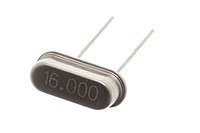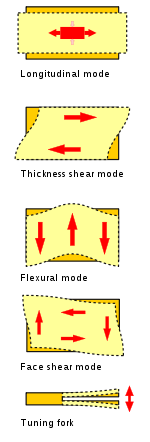
A | B | C | D | E | F | G | H | CH | I | J | K | L | M | N | O | P | Q | R | S | T | U | V | W | X | Y | Z | 0 | 1 | 2 | 3 | 4 | 5 | 6 | 7 | 8 | 9
 A miniature 16 MHz quartz crystal enclosed in a hermetically sealed HC-49/S package, used as the resonator in a crystal oscillator. | |
| Type | Electromechanical |
|---|---|
| Working principle | Piezoelectricity, Resonance |
| Invented | Alexander M. Nicholson, Walter Guyton Cady |
| First production | 1918 |
| Electronic symbol | |
 | |
A crystal oscillator is an electronic oscillator circuit that uses a piezoelectric crystal as a frequency-selective element.[1][2][3] The oscillator frequency is often used to keep track of time, as in quartz wristwatches, to provide a stable clock signal for digital integrated circuits, and to stabilize frequencies for radio transmitters and receivers. The most common type of piezoelectric resonator used is a quartz crystal, so oscillator circuits incorporating them became known as crystal oscillators.[1] However, other piezoelectric materials including polycrystalline ceramics are used in similar circuits.
A crystal oscillator relies on the slight change in shape of a quartz crystal under an electric field, a property known as inverse piezoelectricity. A voltage applied to the electrodes on the crystal causes it to change shape; when the voltage is removed, the crystal generates a small voltage as it elastically returns to its original shape. The quartz oscillates at a stable resonant frequency, behaving like an RLC circuit, but with a much higher Q factor (less energy loss on each cycle of oscillation). Once a quartz crystal is adjusted to a particular frequency (which is affected by the mass of electrodes attached to the crystal, the orientation of the crystal, temperature and other factors), it maintains that frequency with high stability.[4]
Quartz crystals are manufactured for frequencies from a few tens of kilohertz to hundreds of megahertz. As of 2003, around two billion crystals are manufactured annually.[5] Most are used for consumer devices such as wristwatches, clocks, radios, computers, and cellphones. However, in applications where small size and weight is needed crystals can be replaced by thin-film bulk acoustic resonators, specifically if ultra-high frequency (more than roughly 1.5 GHz) resonance is needed. Quartz crystals are also found inside test and measurement equipment, such as counters, signal generators, and oscilloscopes.
Terminology

A crystal oscillator is an electric oscillator type circuit that uses a piezoelectric resonator, a crystal, as its frequency-determining element. Crystal is the common term used in electronics for the frequency-determining component, a wafer of quartz crystal or ceramic with electrodes connected to it. A more accurate term for "crystal" is piezoelectric resonator. Crystals are also used in other types of electronic circuits, such as crystal filters.
Piezoelectric resonators are sold as separate components for use in crystal oscillator circuits. They are also often incorporated in a single package with the crystal oscillator circuit.
History


Piezoelectricity was discovered by Jacques and Pierre Curie in 1880. Paul Langevin first investigated quartz resonators for use in sonar during World War I. The first crystal-controlled oscillator, using a crystal of Rochelle salt, was built in 1917 and patented[6] in 1918 by Alexander M. Nicholson at Bell Telephone Laboratories, although his priority was disputed by Walter Guyton Cady.[7] Cady built the first quartz crystal oscillator in 1921.[8] Other early innovators in quartz crystal oscillators include G. W. Pierce and Louis Essen.
Quartz crystal oscillators were developed for high-stability frequency references during the 1920s and 1930s. Prior to crystals, radio stations controlled their frequency with tuned circuits, which could easily drift off frequency by 3–4 kHz.[9] Since broadcast stations were assigned frequencies only 10 kHz (Americas) or 9 kHz (elsewhere) apart, interference between adjacent stations due to frequency drift was a common problem.[9] In 1925, Westinghouse installed a crystal oscillator in its flagship station KDKA,[9] and by 1926, quartz crystals were used to control the frequency of many broadcasting stations and were popular with amateur radio operators.[10] In 1928, Warren Marrison of Bell Telephone Laboratories developed the first quartz-crystal clock. With accuracies of up to 1 second in 30 years (30 ms/y, or 0.95 ns/s),[8] quartz clocks replaced precision pendulum clocks as the world's most accurate timekeepers until atomic clocks were developed in the 1950s. Using the early work at Bell Labs, AT&T eventually established their Frequency Control Products division, later spun off and known today as Vectron International.[11]
A number of firms started producing quartz crystals for electronic use during this time. Using what are now considered primitive methods, about 100,000 crystal units were produced in the United States during 1939. Through World War II crystals were made from natural quartz crystal, virtually all from Brazil. Shortages of crystals during the war caused by the demand for accurate frequency control of military and naval radios and radars spurred postwar research into culturing synthetic quartz, and by 1950 a hydrothermal process for growing quartz crystals on a commercial scale was developed at Bell Laboratories. By the 1970s virtually all crystals used in electronics were synthetic.
In 1968, Juergen Staudte invented a photolithographic process for manufacturing quartz crystal oscillators while working at North American Aviation (now Rockwell) that allowed them to be made small enough for portable products like watches.[12]
Although crystal oscillators still most commonly use quartz crystals, devices using other materials are becoming more common, such as ceramic resonators.

Principle
A crystal is a solid in which the constituent atoms, molecules, or ions are packed in a regularly ordered, repeating pattern extending in all three spatial dimensions.
Almost any object made of an elastic material could be used like a crystal, with appropriate transducers, since all objects have natural resonant frequencies of vibration. For example, steel is very elastic and has a high speed of sound. It was often used in mechanical filters before quartz. The resonant frequency depends on size, shape, elasticity, and the speed of sound in the material. High-frequency crystals are typically cut in the shape of a simple rectangle or circular disk. Low-frequency crystals, such as those used in digital watches, are typically cut in the shape of a tuning fork. For applications not needing very precise timing, a low-cost ceramic resonator is often used in place of a quartz crystal.
When a crystal of quartz is properly cut and mounted, it can be made to distort in an electric field by applying a voltage to an electrode near or on the crystal. This property is known as inverse piezoelectricity. When the field is removed, the quartz generates an electric field as it returns to its previous shape, and this can generate a voltage. The result is that a quartz crystal behaves like an RLC circuit, composed of an inductor, capacitor and resistor, with a precise resonant frequency.
Quartz has the further advantage that its elastic constants and its size change in such a way that the frequency dependence on temperature can be very low. The specific characteristics depend on the mode of vibration and the angle at which the quartz is cut (relative to its crystallographic axes).[13] Therefore, the resonant frequency of the plate, which depends on its size, does not change much. This means that a quartz clock, filter or oscillator remains accurate. For critical applications the quartz oscillator is mounted in a temperature-controlled container, called a crystal oven, and can also be mounted on shock absorbers to prevent perturbation by external mechanical vibrations.
Modeling
Electrical model
A quartz crystal can be modeled as an electrical network with low-impedance (series) and high-impedance (parallel) resonance points spaced closely together. Mathematically, using the Laplace transform, the impedance of this network can be written as:

or
where is the complex frequency (), is the series resonant angular frequency, and
Antropológia
Aplikované vedy
Bibliometria
Dejiny vedy
Encyklopédie
Filozofia vedy
Forenzné vedy
Humanitné vedy
Knižničná veda
Kryogenika
Kryptológia
Kulturológia
Literárna veda
Medzidisciplinárne oblasti
Metódy kvantitatívnej analýzy
Metavedy
Metodika
Text je dostupný za podmienok Creative
Commons Attribution/Share-Alike License 3.0 Unported; prípadne za ďalších
podmienok.
Podrobnejšie informácie nájdete na stránke Podmienky
použitia.
www.astronomia.sk | www.biologia.sk | www.botanika.sk | www.dejiny.sk | www.economy.sk | www.elektrotechnika.sk | www.estetika.sk | www.farmakologia.sk | www.filozofia.sk | Fyzika | www.futurologia.sk | www.genetika.sk | www.chemia.sk | www.lingvistika.sk | www.politologia.sk | www.psychologia.sk | www.sexuologia.sk | www.sociologia.sk | www.veda.sk I www.zoologia.sk





